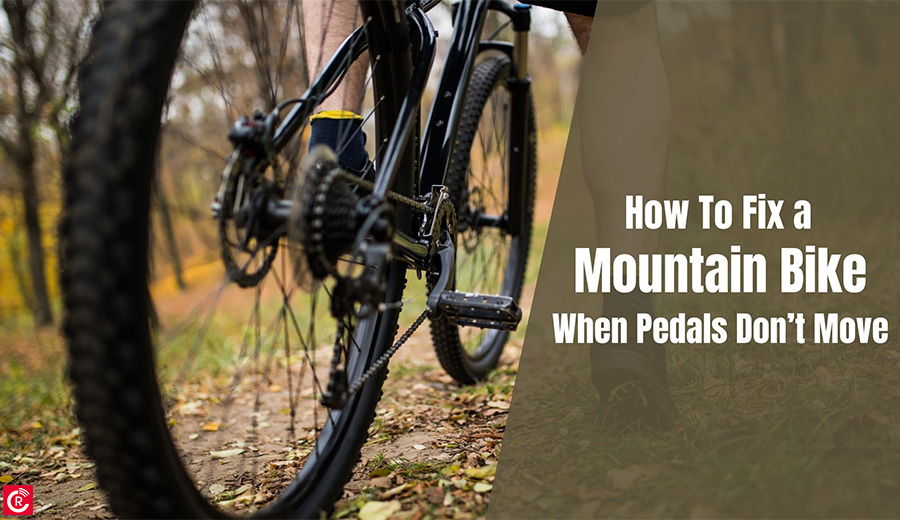
A cycle is propelled with the energy transferred through the pedals from your legs. As a result, if the pedal does not move forward, obviously, the bike will not operate.
Because the bushings are linked to the mechanism, you can presume that they are the source of the problem. They certainly can be. The majority of the time, faulty bearings prevent pedals from moving forward. However, a few other variables influence a pedal to become stuck. So, now the question is why and how the pedals won’t move? To know a potential answer for a stuck pedal and if you would like to solve your sticky troubles, and to get the best mountain bikes free of pedal trouble keep reading.
Why bike pedals won’t move forward
Bike pedals won’t move when the pedal bearings are too worn out and rusty. Besides, a short braking cable or incorrect chain alignment can cause the fake pedal to get stuck. Likewise, bike pedals will not move forward because the pedal joints are too rusted and torn out. A false pedal can also be caused by poor chain alignment or a shorter brakes wire.
- Rusty bearings: You may haven’t ridden in a long period of time and have neglected to maintain your bike. As a result, the bearing erodes to the point that they can no longer spin the wheels. The very same thing is happening on the back cog of a single-speed fixie. The pedal becomes stuck because it is attached to the chain, and the gear does not turn.
- Dusty rear cog: For dusty rear cog, an electronic pedal becomes stuck. The cog becomes significantly polluted, mainly while biking through brush or dirt. Furthermore, foreign objects such as hay or grass moved around in the tapes, clogging the freewheel. As a result, the cassette stops turning, and the pedals do not move ahead.
- Chain stuck: After just a collision, the stopping and gearing elements, such as derailleurs or brakes, become severely misplaced. As a result, the chain becomes jammed in various places, including the chain ring cage. The pedals can’t shift ahead because the chain is stuck. Furthermore, the discs brakes can be significantly twisted, preventing the whole tire from rotating. As a result, an artificial pedal may become stuck.
What should you do if your bicycle pedals stop moving forward?
To begin, you must find the root of the problem. Next, rotate the wheel in the other direction. The issue is likely with the pedal rather than the tire if it’s rotating. If the tire is in good shape, try moving the pedals backward and forth. If they aren’t going and are frozen in place, then Finally, inspect the brakes and chains. They may blame the stuck because they’re not aligned properly or are significantly bent. Anyway, once you’ve identified the issues, use the recommendations below to find a solution.
Step:1 Repairing the brake caliper.
You should first check the pedal if they have a fault. For example, the bottom bearing turns the pedal or spindle. As a result, you’ll need to take out the brake caliper and inspect the bearings and shaft. The BB removal and installation method, on the other hand, is detailed in the BB Removal and Replacement Guide.
1. Check the shaft and bushings first. You’ll need to replace the base of the spindle is damaged or rusted. Instead, you can replace or repair the bearings. But first, double-check the bearing. Is it possible to repair it? If this is the case, clean it, oil it, and replace it.
2. You will almost always need to replace the gear. So, get a BB Bearing that fits your needs. Then grease it before reinstalling it.
Step 2: Switching freewheels or cassettes
Replace the freewheel or tapes if they are destroyed from the inside and cannot be repaired. Before proceeding, you must first determine if your bicycle has a freewheel or a cassette setup. A cassette system comprises 5 to 10 spare cogs and a free-hub where the cogs are continuously built-in to the freewheel.
As a result, you can’t use them interchangeably. Furthermore, the method and elimination method varies significantly from those.
Now, learn how to swap out the free-hub body or cassettes.
1. First, examine the back cog-set to determine whether it’s a matrix or freewheel design. To do so, remove the simple mechanism and remove the bike’s rear wheel. Next, examine the cog-center set’s present. It’s a cassette method if there is a lock ring. Aside from that, it’s a freewheel. Need a fresh Freewheel or a new free-hub when needed.
2. Replace the cassettes or freewheel in the second phase. You’ll need a Freewheel Tool Called to remove the freewheel. With such a Hex Key, you can quickly remove the tapes. To remove the lock ring, you have to turn the key. Now, using a Torque Wrench, detach the free-hub and the spindle. Then, using the free-hub body as a guide, disconnect it.
3. Finally, wash the center and reinstall the new parts in the same order that the old ones were uninstalled. However, be confident that no element is cross-threaded. Replace the tire and perfect the bicycle at the end.
Step 3: Adjust the valves and sprocket.
Not just whether the bicycle collapsed, you should fine-tune it. Inspect for any bends in the gear cage or rack before proceeding.
Examine the rotors and brake controls as well. Repair them first, and if they’re bent. Then proceed to the following stages.
1. First, see if the brakes are operational. Bike Brake Adjustment should be performed if there is indeed a difficulty.
2. Straighten out the crooked hanger. After that, double-check the chain length. Isn’t it supposed to be horizontal to the cogs? Then you’ll require Rear Derailleur Adjustment.
Conclusion
The bike’s spinning parts come to a halt, causing the pedal to become stuck. As a result, you must keep those parts clean and oiled. It’s essential for the effective operation of the pedals and wheel, which is required to prevent the pedal from being jammed. Clean the back cog and lube the freewheel initially, in any case. You’re ready to start once you’ve found an appropriate oil. In addition, if you still get stuck, you should know the root of your problem to solve it, and once you know why you cannot move the pedals, use the solutions accordingly.





